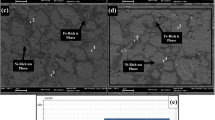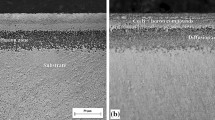Abstract
The dry sliding wear behavior of high-leaded tin bronze alloy was analyzed after multidirectional forging (MDF). The effect of MDF on the wear performance was analyzed under various loads, sliding velocities, and sliding distances. X-ray diffraction (XRD) analysis and energy-dispersive X-ray spectroscopy (EDS) were carried out on wear surfaces to define the wear mechanism, and field-emission scanning electron microscopy to observe microstructures. The change in the dislocation density on the wear track was also measured using XRD peak broadening analysis. MDF alloys showed higher wear resistance than as-received (AR) alloy. The major factors responsible for the improved wear resistance were (a) improved mechanical strength due to decreased crystalline size, and (b) presence of high lead content in the alloy.













Similar content being viewed by others
References
T.C. Lowe, R.Z. Valiev, The use of severe plastic deformation techniques in grain refinement. JOM 56(10), 64–68 (2004)
A. Azushima, R. Kopp, A. Korhonen, D. Yang, F. Micari, G. Lahoti, P. Groche, J. Yanagimoto, N. Tsuji, A. Rosochowski, Severe plastic deformation (SPD) processes for metals. CIRP Ann. Manuf. Technol. 57(2), 716–735 (2008)
J. Xing, H. Soda, X. Yang, H. Miura, T. Sakai, Formation of fine grained structure in a magnesium alloy AZ 31 during multi-directional forging with decreasing deformation temperature. J. Jpn. Inst. Light Met. 54(11), 527–531 (2004)
R. Gupta, S.K. Panthi, S. Srivastava, Assessment of various properties evolved during grain refinement through multi-directional forging. Rev. Adv. Mater. Sci. 46, 70–85 (2016)
O. Valiakhmetov, R. Galeyev, G. Salishchev, Mechanical properties of the titanium alloy VT8 with submicrocrystalline structure. Phys. Met. Metall. 70(4), 198–200 (1990)
R. Galeyev, O. Valiakhmetov, G. Salishchev, Dynamic crystallization of coarse grained titanium base VT8 alloy in (a + b) Field. Russ. Metall. 4, 97–103 (1990)
S. Zherebtsov, G. Salishchev, R. Galeyev, O. Valiakhmetov, S.Y. Mironov, S. Semiatin, Production of submicrocrystalline structure in large-scale Ti–6Al–4V billet by warm severe deformation processing. Scr. Mater. 51(12), 1147–1151 (2004)
K. Zohdy, M. Sadawy, M. Ghanem, Corrosion behavior of leaded-bronze alloys in sea water. Mater. Chem. Phys. 147(3), 878–883 (2014)
A.P. Zhilyaev, I. Shakhova, A. Belyakov, R. Kaibyshev, T.G. Langdon, Wear resistance and electroconductivity in copper processed by severe plastic deformation. Wear 305(1), 89–99 (2013)
L. Gao, X. Cheng, Microstructure, phase transformation and wear behavior of Cu–10% Al–4% Fe alloy processed by ECAE. Mater. Sci. Eng. A 473(1), 259–265 (2008)
S. Equey, A. Houriet, S. Mischler, Wear and frictional mechanisms of copper-based bearing alloys. Wear 273(1), 9–16 (2011)
L. Gao, X. Cheng, Microstructure and dry sliding wear behavior of Cu–10% Al–4% Fe alloy produced by equal channel angular extrusion. Wear 265(7), 986–991 (2008)
M.I.A. El Aal, H.S. Kim, Wear properties of high pressure torsion processed ultrafine grained Al–7% Si alloy. Mater. Des. 53, 373–382 (2014)
S.-J. Huang, V. Semenov, L.S. Shuster, P.-C. Lin, Tribological properties of the low-carbon steels with different micro-structure processed by heat treatment and severe plastic deformation. Wear 271(5), 705–711 (2011)
E. Ortiz-Cuellar, M. Hernandez-Rodriguez, E. García-Sanchez, Evaluation of the tribological properties of an Al–Mg–Si alloy processed by severe plastic deformation. Wear 271(9), 1828–1832 (2011)
K. Edalati, M. Ashida, Z. Horita, T. Matsui, H. Kato, Wear resistance and tribological features of pure aluminum and Al–Al2O3 composites consolidated by high-pressure torsion. Wear 310(1), 83–89 (2014)
P. La, J. Ma, Y.T. Zhu, J. Yang, W. Liu, Q. Xue, R.Z. Valiev, Dry-sliding tribological properties of ultrafine-grained Ti prepared by severe plastic deformation. Acta Mater. 53(19), 5167–5173 (2005)
M.I.A. El Aal, N. El Mahallawy, F.A. Shehata, M.A. El Hameed, E.Y. Yoon, H.S. Kim, Wear properties of ECAP-processed ultrafine grained Al–Cu alloys. Mater. Sci. Eng. A 527(16), 3726–3732 (2010)
A.K. Padap, G.P. Chaudhari, S.K. Nath, Dry Sliding Wear Behavior of Ultrafine-Grained Mild Steel Processed Using Multi Axial Forging, Chemistry for Sustainable Developmented. (Springer, Berlin, 2012), pp. 219–230
A. Padap, G. Chaudhari, S. Nath, Mechanical and dry sliding wear behavior of ultrafine-grained AISI 1024 steel processed using multiaxial forging. J. Mater. Sci. 45(17), 4837–4845 (2010)
J.R. Davis, Copper and Copper Alloys (ASM International, Almere, 2001)
R. Gupta, S. Srivastava, N.K. Kumar, S.K. Panthi, High leaded tin bronze processing during multi-directional forging: effect on microstructure and mechanical properties. Mater. Sci. Eng. A 654, 282–291 (2016)
B. Prasad, Sliding wear behaviour of bronzes under varying material composition, microstructure and test conditions. Wear 257(1), 110–123 (2004)
Y. Zhao, Z. Horita, T. Langdon, Y. Zhu, Evolution of defect structures during cold rolling of ultrafine-grained Cu and Cu–Zn alloys: influence of stacking fault energy. Mater. Sci. Eng. A 474(1), 342–347 (2008)
F.E. Kennedy, Thermal and thermomechanical effects in dry sliding. Wear 100(1), 453–476 (1984)
B. Prasad, A. Patwardhan, A. Yegneswaran, Factors controlling dry sliding wear behaviour of a leaded tin bronze. Mater. Sci. Technol. 12(5), 427–435 (1996)
L. Chen, D. Rigney, Transfer during unlubricated sliding wear of selected metal systems. Wear 105(1), 47–61 (1985)
O. Modi, B. Prasad, A. Yegneswaran, M. Vaidya, Dry sliding wear behaviour of squeeze cast aluminium alloy-silicon carbide composites. Mater. Sci. Eng. A 151(2), 235–245 (1992)
D. Rigney, L. Chen, M.G. Naylor, A. Rosenfield, Wear processes in sliding systems. Wear 100(1), 195–219 (1984)
O. Yilmaz, H. Turhan, Effect of size and volume fraction of particulates on the sliding wear resistance of CuSn composites (vol 249, pg 901, 2001). Wear 252(1–2), 170 (2002)
J.J. Wert, W.M. Cook, The influence of stacking fault energy and adhesion on the wear of copper and aluminum bronze. Wear 123(2), 171–192 (1988)
S. Alam, R. Marshall, S. Sasaki, Metallurgical and tribological investigations of aluminium bronze bushes made by a novel centrifugal casting technique. Tribol. Int. 29(6), 487–492 (1996)
A. Kenneford, C. Oxlee, V. Rance, Application of Ausforming to Some Low Alloy Steels’, Pub. 114 on Low Alloy Steels, Iron and Steel Institute, London, UK, 91–96 (1969)
D. Rigney, J. Hirth, Plastic deformation and sliding friction of metals. Wear 53(2), 345–370 (1979)
T. Eyre, A. Baxter, The formation of white layers at rubbing surfaces. Tribology 5(6), 256–261 (1972)
J. Larsen-Badse, K. Mathew, Influence of structure on the abrasion resistance of a 1040 steel. Wear 14(3), 199–205 (1969)
Z. Shi, Y. Sun, A. Bloyce, T. Bell, Unlubricated rolling-sliding wear mechanisms of complex aluminium bronze against steel. Wear 193(2), 235–241 (1996)
L. Gao, X. Cheng, Effect of ECAE on microstructure and tribological properties of Cu–10% Al–4% Fe alloy. Tribol. Lett. 27(2), 221–225 (2007)
Z. Zhang, S. Hosoda, I.-S. Kim, Y. Watanabe, Grain refining performance for Al and Al–Si alloy casts by addition of equal-channel angular pressed Al–5mass% Ti alloy. Mater. Sci. Eng. A 425(1), 55–63 (2006)
A. Moshkovich, V. Perfilyev, D. Gorni, I. Lapsker, L. Rapoport, The effect of Cu grain size on transition from EHL to BL regime (Stribeck curve). Wear 271(9), 1726–1732 (2011)
A. Moshkovich, V. Perfilyev, I. Lapsker, D. Gorni, L. Rapoport, The effect of grain size on Stribeck curve and microstructure of copper under friction in the steady friction state. Tribol. Lett. 42(1), 89–98 (2011)
L. Gao, X. Cheng, Microstructure and mechanical properties of Cu–10% Al–4% Fe alloy produced by equal channel angular extrusion. Mater. Des. 29(4), 904–908 (2008)
Author information
Authors and Affiliations
Corresponding author
Rights and permissions
About this article
Cite this article
Gupta, R., Srivastava, S., Panthi, S.K. et al. Multidirectional Forging of High-Leaded Tin Bronze: Effect on Wear Performance. Metallogr. Microstruct. Anal. 6, 577–590 (2017). https://doi.org/10.1007/s13632-017-0394-1
Received:
Revised:
Accepted:
Published:
Issue Date:
DOI: https://doi.org/10.1007/s13632-017-0394-1




